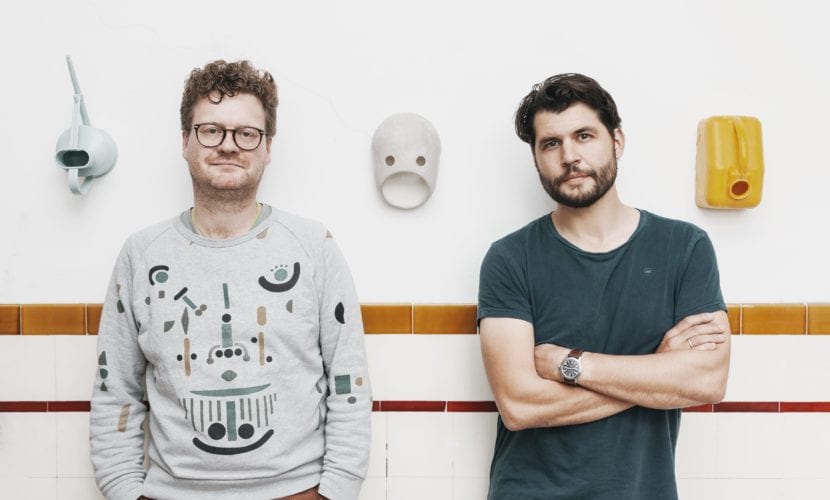
Budding Bond
The interview below was published in FRAME 129, the July/August issue of 2019.
Words Shonquis Moreno
As part of Moooi’s first set of year-round international product releases, More Moooi Moments, Dutch design studio Kranen/Gille launched The Party collection late last year. The series of five wall lamps inspired by masks used to frighten away bad spirits are hyper-minimal and yet shine with character. During Moooi’s ‘A Life Extraordinary’ exhibition at Milan Design Week, The Party made harmony as a singing chandelier. Not much later, as Moooi prepared to introduce the studio’s Plant Chandelier at NYCxDesign, Frame spoke with Design Academy Eindhoven graduates and ’s-Hertogenbosch-based designers Jos Kranen and Johannes Gille about their blossoming relationship with Moooi.
You describe your work as ‘industrial poetry’ and ‘neo-Art Deco’. How would you define these styles and how are they reflected in your work?
JOS KRANEN: We’re intrigued by floral life and the way nature, seemingly abstract, in fact has a very rigid order. Just look at photographer Karl Blossfeldt’s hyper-close-up floral images. This repetitive, fractal-type order can be found in industry, but it’s nice to acknowledge that this is just a copy of nature’s logic.
JOHANNES GILLE: We try to connect nature and industry in our Plant Chandelier, which we describe as ‘neo-Art Deco’ because it bears resemblance to the Jugendstil and Art Deco movements. And, we’re searching for some poetry amid the tools of industry, therefore: ‘industrial poetry’.
It’s been said that your style proves there is still room for new design classics. What characteristics make a design a ‘new classic’?
JK: All too often we see a copy of the past being presented as the ultimate ‘now’. That’s not how things should be. A design should be timeless in a way that is contemporary yet future-proof. It should be just as invigorating in 30 years’ time as it is now.
JG: And if we can achieve this, a product can fit in lots of different environments and becomes extra sustainable.
Your early work is more rooted in gallery pieces, shown at fairs such as Design Miami and PAD London. Why did you decide to make the step towards working with consumer brands?
JK: We love to go about our business unhindered, and to approach design as if it were sculpting. A museum piece affords much more freedom when it comes to size, finish and technique than a consumer product does. At some point, though, we wanted to make our work more widely available. As a designer, it’s great to be able to go your own way, but it’s even better to see your work at airports, in restaurants and in people’s homes.
JG: We were strongly motivated to complete the puzzle: to make objects that can be mass-produced without losing their essence.
What relationship do you see between Kranen/Gille and the world of Moooi, in terms of vision, identity, design language or work methods?
JK: Working with Moooi feels like working with an extension of the studio. Moooi tackles things hands-on and values authenticity and authorship. That’s why they developed The Button, an NFC-based authenticity certificate that lets consumers know they have a genuine product, not a copy.
JG: In our minds, we create a whole world or story around our projects, which gives them depth you can feel without even knowing the narrative. Moooi, unlike other brands, can’t get enough of these background stories and uses every detail.
In creating The Party collection and Plant Chandelier, how did the team at Moooi help you overcome production challenges?
JK: By simply adding a different perspective. As a designer, you tend to have a rather dogmatic view of your work. That’s necessary to ensure that it doesn’t lose its signature. However, it’s important to have a good team that can make the necessary adjustments without losing any of the artistic value.
What types of spaces – commercial, residential – do you envision your designs for Moooi inhabiting?
JG: I would love to see them in the lobby of an Art Deco hotel in New York. With both of our Moooi projects we had a strong association with the Roaring Twenties. But I can see them in a more modern environment, too, I think they could complete a grand hotel atmosphere without feeling out of place.
What conversations do you want the Plant Chandelier to spark?
JK: We use the steel structure of the fixture to power the LED, which is a sign of the times we live in: low-voltage DC makes our life so much easier and safer.